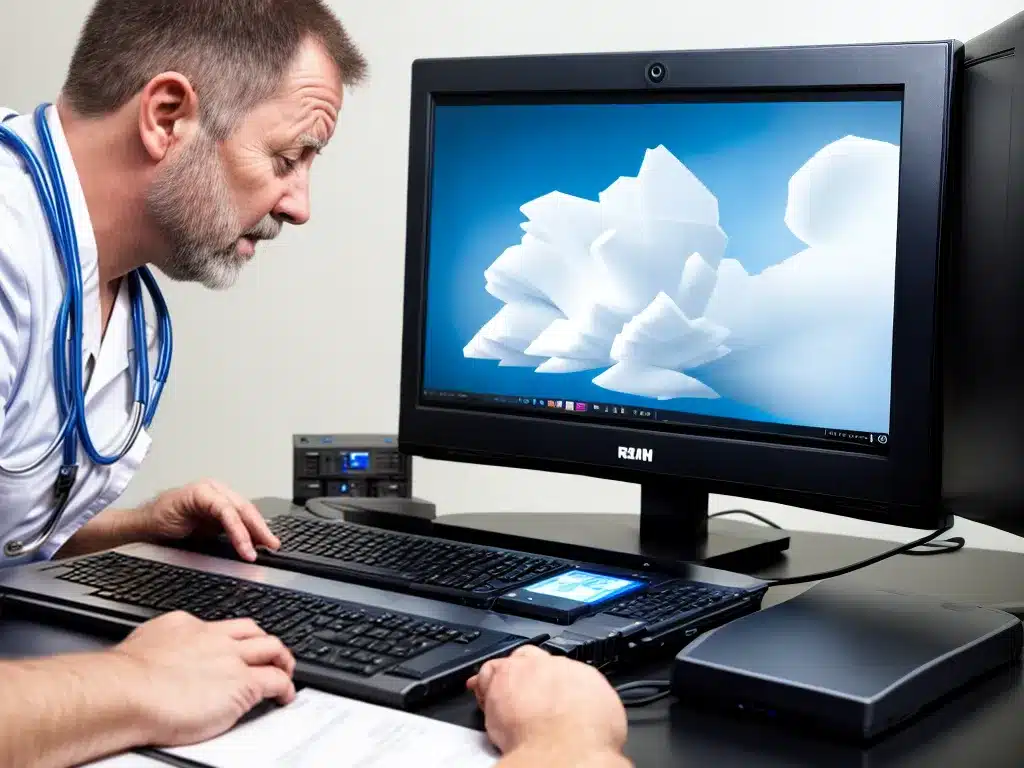
Computer RAM (Random Access Memory) is an important component that allows your computer to store and access data quickly. Faulty RAM can cause a number of problems like random crashes, blue screens of death, freezes, lag, failure to boot, and more. As a computer user, it’s important to know how to diagnose RAM issues so you can identify and replace faulty RAM modules.
What Causes RAM To Fail
There are several potential causes of RAM failure:
-
Manufacturing Defects – Imperfections in the manufacturing process can cause RAM chips to fail prematurely.
-
Heat Damage – Excessive heat can degrade RAM chips over time leading to corruption and failure. Dust buildup preventing proper airflow can contribute to overheating.
-
Physical Damage – Dropping or jarring your computer can physically damage RAM sticks causing connection issues.
-
Electrical Issues – Power surges, spikes, and fluctuations can damage RAM chips.
-
Software Conflicts – Buggy software and driver issues can sometimes corrupt data in RAM.
-
Old Age – RAM modules have a limited lifespan and can degrade over years of heavy use.
Symptoms of Failing RAM
Some common signs your computer may have faulty RAM include:
-
Random crashes/freezes – A buggy RAM stick can cause sudden system crashes or lockups during regular operation.
-
Blue screen errors – Faulty RAM is one of the most common causes of critical BLUE SCREEN OF DEATH errors. Common error codes include
MEMORY_MANAGEMENT,IRQL_NOT_LESS_OR_EQUALandPAGE_FAULT_IN_NONPAGED_AREA. -
Data corruption – Corrupted data like documents, media files, or program malfunctions can indicate RAM failure.
-
High memory usage – RAM bottlenecks can cause high memory usage and constant page swapping to disk.
-
Boot failures – If RAM is too damaged, it can prevent your system from booting altogether.
-
Hardware beeping – Some computers will beep in specific patterns to indicate RAM issues.
-
Visual artifacts – Glitches, flashes, static on the screen can occur with a malfunctioning graphics card or RAM.
How To Diagnose Faulty RAM
If you suspect a RAM problem, there are a few options to help diagnose it:
Check RAM Usage
Use the Task Manager (Ctrl + Shift + Esc) to view memory usage. Consistently high usage over 85% indicates you may need more RAM or have a faulty stick.
Verify RAM Seating
Open your computer case and ensure each RAM stick is clicked fully into place in the motherboard memory slots. Reseat sticks and try booting.
Test RAM with MEMTEST86+
MEMTEST86+ is a free RAM test utility that boots from a USB drive and performs extensive testing. Let it run several passes (6+ hours). Any single error indicates a RAM defect.
Test RAM Sticks Individually
Remove all but one stick of RAM and test booting to see if problems persist. Repeat for each stick individually to isolate failures.
Check Event Viewer
System crash logs and hardware error messages logged in the Event Viewer can help pinpoint faulty RAM as the cause.
Use Windows Memory Diagnostic
This built-in Windows tool runs on boot and checks for RAM issues. Let it scan overnight for thorough testing.
Test Alternate RAM Slots
Try inserting RAM sticks in different motherboard slots to test if slot connectors are faulty.
Update Drivers/BIOS
Outdated drivers and BIOS can sometimes cause RAM incompatibilities. Update to latest software.
How To Fix RAM Issues
Once you’ve identified the faulty RAM stick, fix options include:
-
Reseat/swap slots – Seating issues cause many apparent RAM failures. Reseating sticks often helps.
-
Clean RAM contacts – Use isopropyl alcohol to clean gold RAM contacts if corrosion is present.
-
Test with new RAM – Replace suspect sticks with new ones to verify RAM is causing the problem.
-
Increase RAM – Adding more RAM can help resolve out-of-memory crashes and bottlenecks.
-
RMA/Warranty replacement – If RAM is still under warranty, contact the manufacturer for an RMA replacement.
-
Buy new RAM – Purchase new compatible RAM sticks to replace any that are damaged or degraded.
-
Reset CMOS – Reset BIOS settings to default to resolve any RAM compatibility issues with overclocks or misconfigured settings.
Diagnosing faulty RAM requires patience but paying attention to telltale symptoms can help identify and prevent many computer problems. Stress testing tools like MEMTEST86+ can pinpoint errors accurately. Reseating, cleaning or replacing RAM sticks will typically get your system back up and running at full speed.












